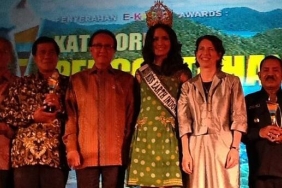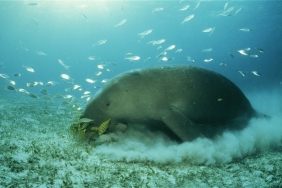WANT TO OBSERVE DUGONGS IN ALOR? FOLLOW THIS GUIDE, KEEP AN EYE ON THE CONSERVATION AREA TOGETHER
By: Alexandra M. Waskita (Dugong & Seagrass Conservation Program (DSCP) Site Manager, Alor)
Read More: These 3 Alor Ecotourism Villages Are Great for You to Visit with Your Family!
Dugong marine mammals (Dugong dugon) are currently one of the tourism attractions of Alor Regency. Mawar, the name of the dugong that inhabits seagrass habitat in the waters of Mali Beach, Kabola Village.
Based on the International Union for Conservation of Nature (IUCN) criteria, dugongs are classified as vulnerable ("Vulnerable") to extinction. Unfortunately, tourism pressure for this protected biota is getting higher. Meanwhile, public understanding and legal basis regarding dugong protection are still not strong.
To preserve the dugong, the procedure for dugong watching tourism has been regulated in the Regent Regulation of Alor Regency No. 7/2018.
In Expo Alor 2018 (20/09/18), tourists who come to Alor get socialization about what should and what should not be done when observing dugongs.
"In the Alor Perbup, it has been emphasized that visitors should not swim and hold, feed, or disturb dugongs in their habitat," Mr. Ans Takalapeta - NTT DPRD and former Regent of Alor Regency - was one of the visitors to the stand at Expo Alor 2018 sharing knowledge about dugong observation tourism procedures.
"Observation is also encouraged to be done only from the boat, using local community boats, which are managed by two groups in the Mali area, Kabola Village, namely the Ol Oho Group and the Mail Maha Group," he continued. The efforts made aim to reduce the pressure from uncontrolled and irresponsible tourism that is practiced in Alor.
Not only socialization on how to observe dugongs, materials on protected marine animals based on Law No.5/1990 also enlivened Expo Alor 2018. This is important to provide information to visitors about the protection of marine mammals as an important asset of Alor Regency that must be maintained together in the SAP Pantar Strait marine conservation area in Alor which was established since 2015. At the same time, it is an initial effort to increase public awareness so that it can help support government policies at the national level.
"This kind of socialization activity is very important, so that more people know the types of marine animals protected by the government," said Mualim Prasong, one of the visitors who is a young man from Teluk Mutiara District.
Public Participation to Follow Conservation Area Monitoring
In Expo Alor, some visitors also provided information about destructive fishing activities that occur in the waters of Alor Regency.
"Tanjung Margeta, Pureman, this area is one of the bomb targets. Hopefully (attention and) supervision of this area can be higher," said Mr. Dominggus, a teacher of Langkuru Junior High School from Pureman Sub-district.
Some areas in Alor are also often threatened by illegal and destructive fishing activities originating from within or outside the waters of the district - even Indonesia.
The tourism and fisheries aspects of Alor can continue if the resources are also protected. Each component of society, whether from the local population, the private sector, the government or law enforcement officials have different obligations. But one in common, the responsibility to care and maintain.
The community can contribute by cooperating with tour operators, local NGOs, and the government by reporting destructive fisheries violations to the Pantar Strait and Surrounding Seas SAP management unit (DKP NTT).
As for irresponsible tourism, especially violations of the Regent's Regulation regarding dugong observation, it can be reported to the Alor Regency Tourism Office (Mr. Soni, 0852 391 76123 / Mr. Ferry, 0822 66187 640). Alternatively, you can report such events through WWF-Indonesia's Marine Buddies app.





